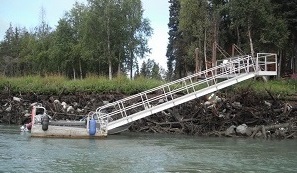Docks and Ramps
Best Practices
Using the Best Practices below can help avoid and minimize impacts to fish and habitat related to construction and maintenance of docks or ramps. Contact your local Habitat Section office for assistance with fish-friendly design and construction techniques.

Access ramp and floating dock on Kenai River
- Construction should avoid sensitive life stages to avoid and minimize impacts to fish. Contact your local Habitat Section office for more information on timing windows for your area.
- Docks and ramps should be properly maintained and removed from the waterbody when no longer in use.
- Seasonal removal and installation of floating docks or ramps should minimize disturbance of the streambank or lakeshore.
Docks
- Docks and access ramps should use light penetrating materials to the extent practicable along streambanks and lakeshores to protect riparian vegetation (board spacing of ½” or more is preferred over water).
- Floating docks should be constructed using materials that will not become waterlogged or sink when punctured. Styrofoam should NOT be used for floatation unless fully encapsulated in plastic or other means of containment.
- The use of a vibratory hammer for pile driving can reduce the potential for impacts related to noise and underwater sound pressure. Impact driving should be minimized to the extent possible when fish are present.
- Wood used for dock construction should be pressure treated and should not be treated with any preservative containing pentachlorophenol or creosote. Wood preservatives should not be applied using surface applications such as painting or spraying.
